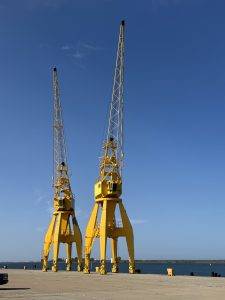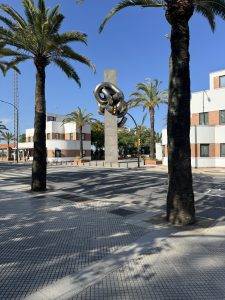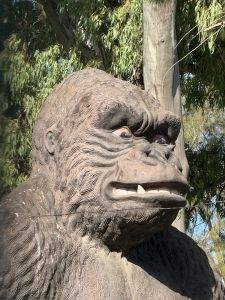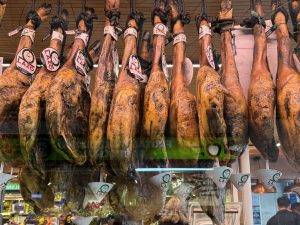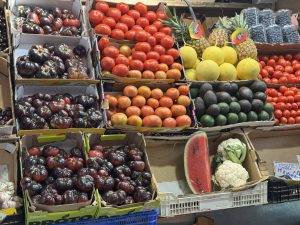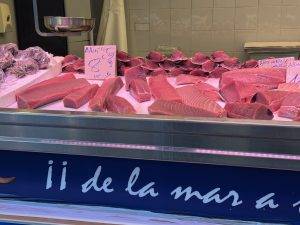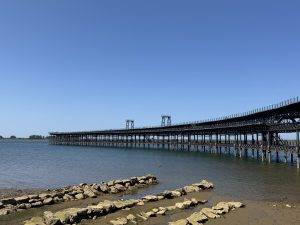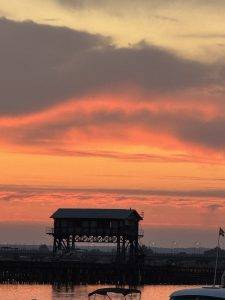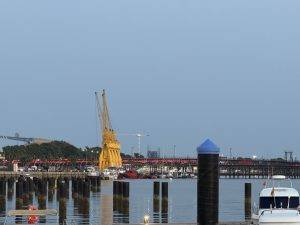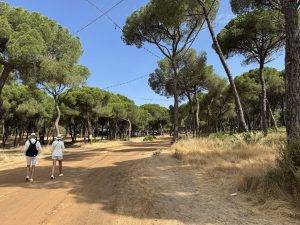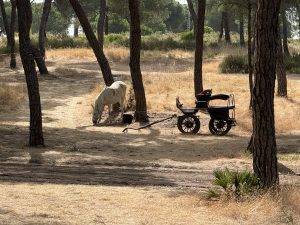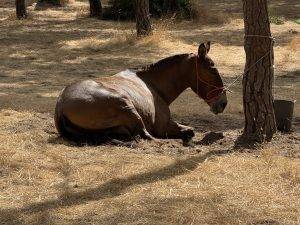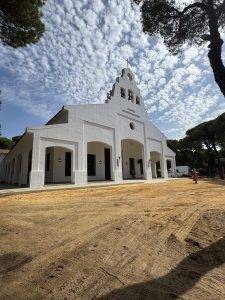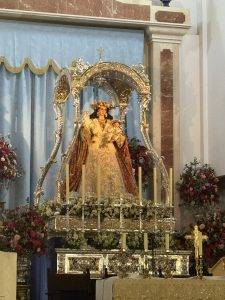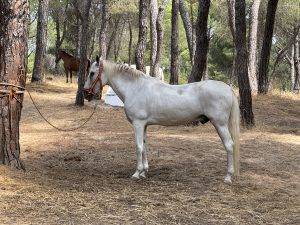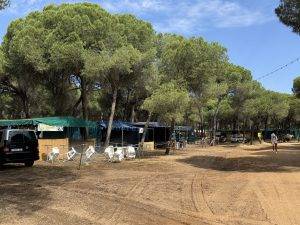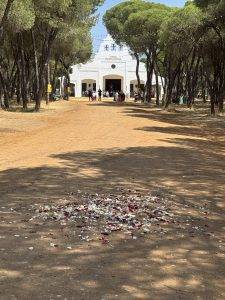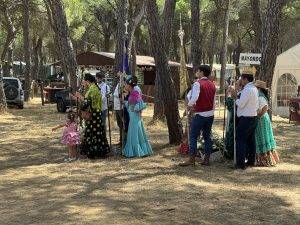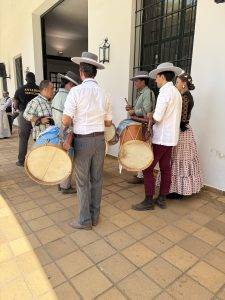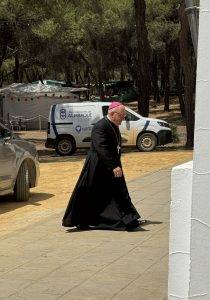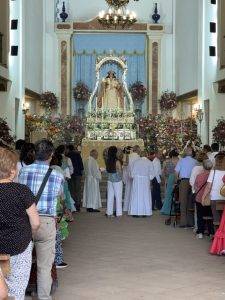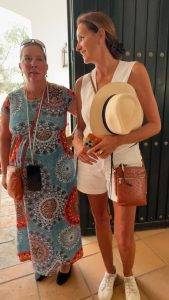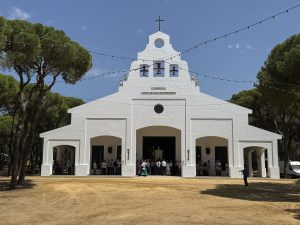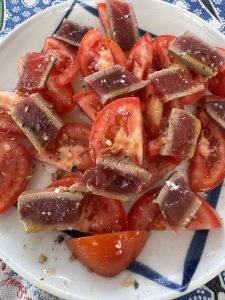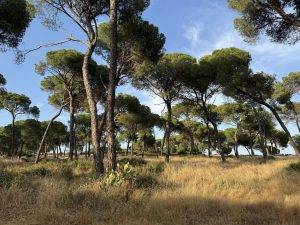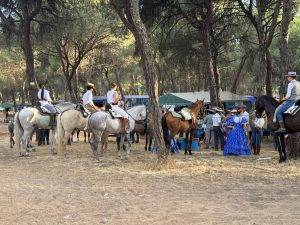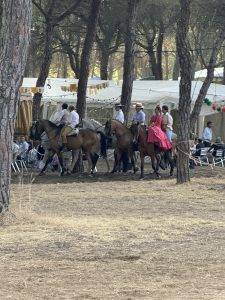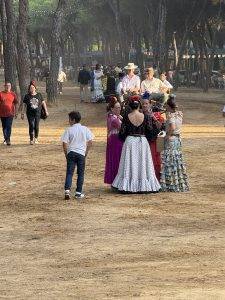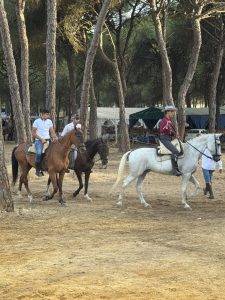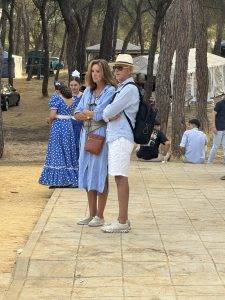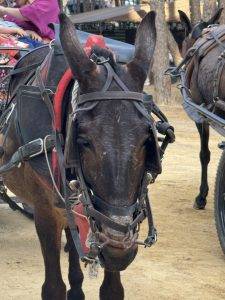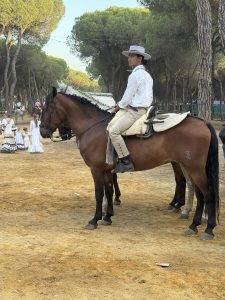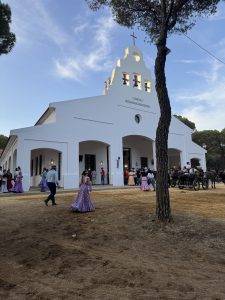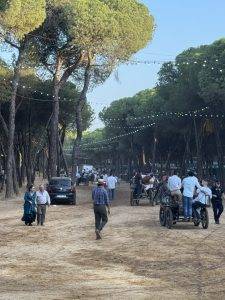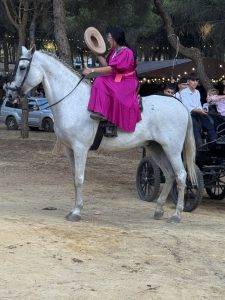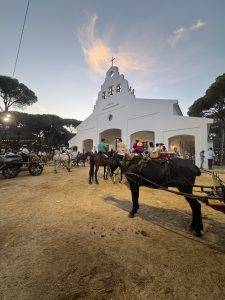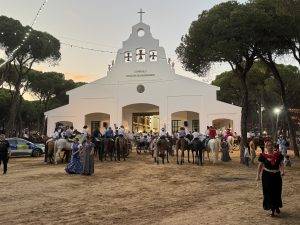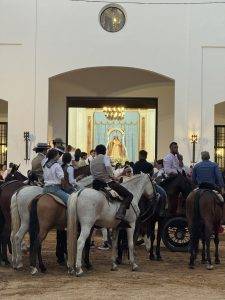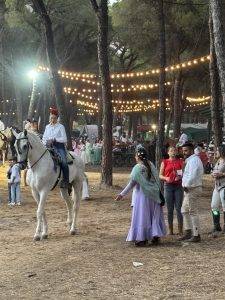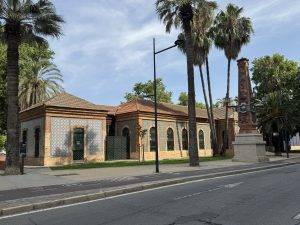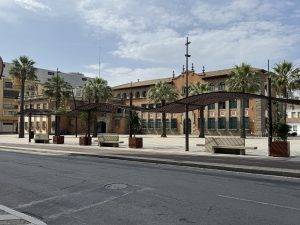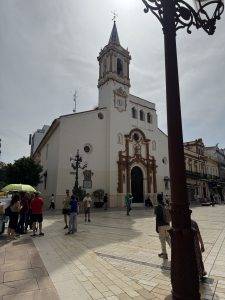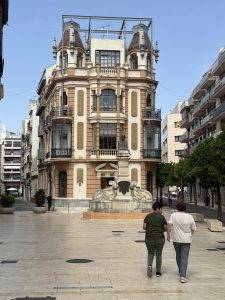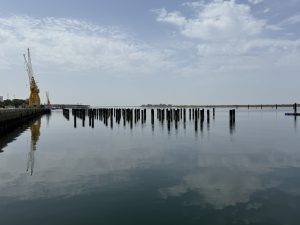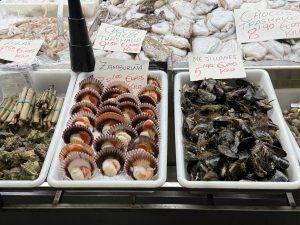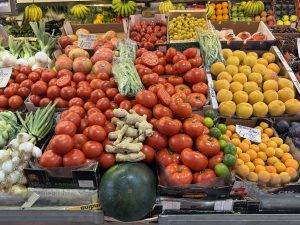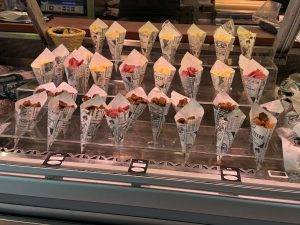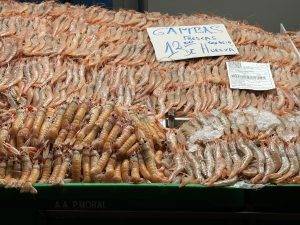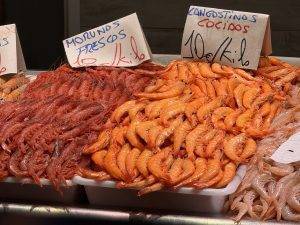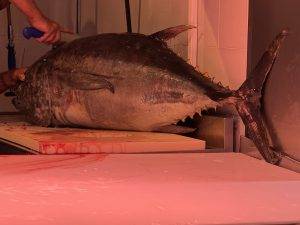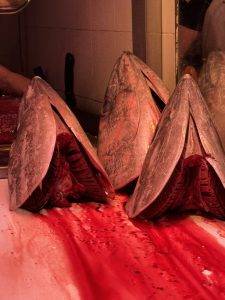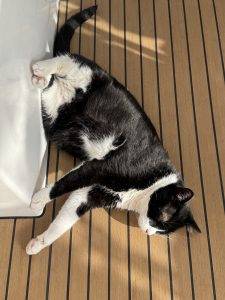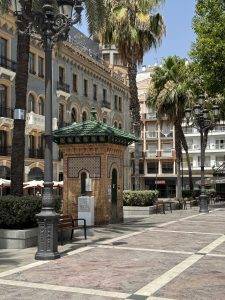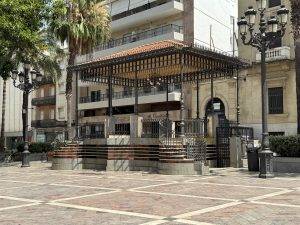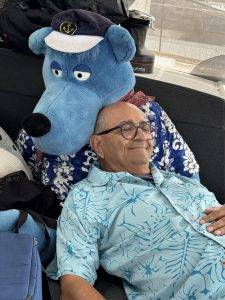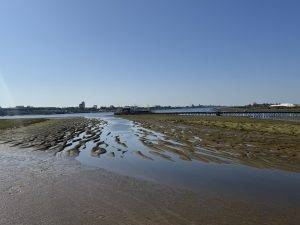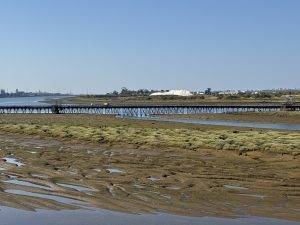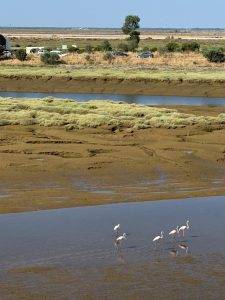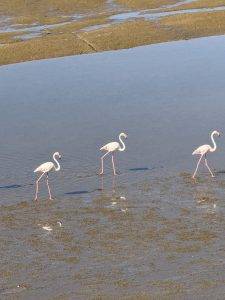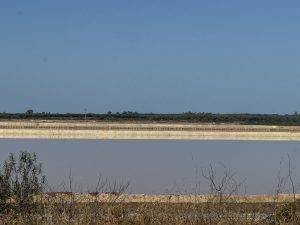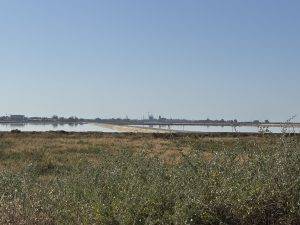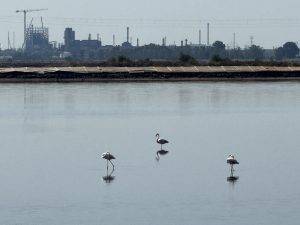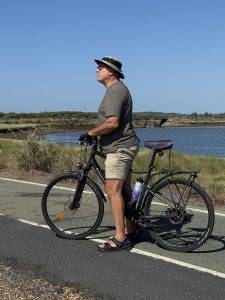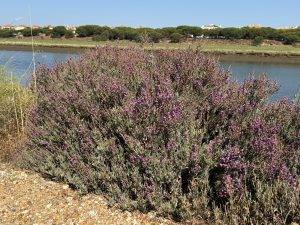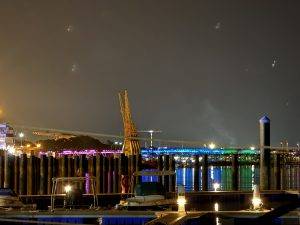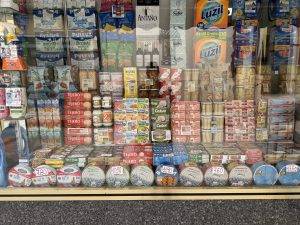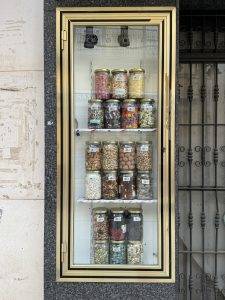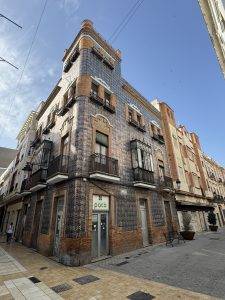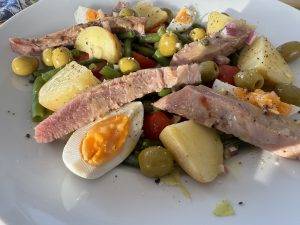Our time in Huelva is off to a hot start! The forecast for the weekend is again over 35° C. So we get up early today to make the most of the slightly cooler morning temperatures. We make our way to the market on foot. We walk out of the harbor area, through a small park and there we are. Not even 10 minutes. Unfortunately, the Mercado del Carmen is not an exceptional beauty, but its inner values are impressive! While queues form in front of the hall at the churro stands, we go straight inside and wander through the numerous aisles. There is everything your heart desires here. The fish and seafood offering is particularly stunning. The displays are stacked with dozens of different types of prawns, prawns, langoustines and even lobster. In the stand next to it are huge tuna heads and equally large tuna steaks. The prices for the different pieces of tuna range from €8 to €32 per kilo. We have to go for it. We buy two beautiful slices of tuna fillet from the local Almadraba tuna. Almadraba refers to both the nets and a traditional way of catching tuna. Almadraba translates as something like „the place where they beat and fight“. The nets anchored to the seabed with large. The nets, which are anchored to the seabed with large anchors, act like a giant gillnet in which the tuna gather. The fish are then hoisted out of the nets onto the deck of the boats by the fishermen and killed there – previously beaten to death with clubs, but nowadays stabbed more gently and quickly. Although this may sound brutal at first, it is a very sustainable method of catching tuna, which – as it is caught and killed without any stress – produces specimens of particularly high quality. Almadraba is seasonal, from around April to July, so we are in Andalusia at just the right time to enjoy some of these delicacies. However, the almadraba nets are currently making things a little more difficult for sailors on their way from the Algarve to Gibraltar. In some cases, they extend from land into deep water and have to be circumnavigated. At the moment, the orcas are also out in the deep water in front of the nets, as they would also like to get some of the tuna shoals. And when they have had their fill, they unfortunately set their sights on the oars of the sailors as an exciting pastime. This is why there are so many orca attacks in the region. Even though the nets are actually allowed to be deployed from April to November, they often disappear as early as July. So if you want to go in or out of the Mediterranean, you have a good chance of avoiding the orcas from August to March, because you can stay in water depths of less than 20 m and don’t have to go around any nets. Back to our visit to the market. We buy more ingredients for delicious tuna tacos and are impressed by the ham, meat and fruit and vegetable selection. Finally, we head back on board, where we stow away our purchases. While Axel devotes himself to a new 3D printing project, I cycle around a bit until it gets too warm for that. From midday onwards, all you can really do is remain motionless in the shady cockpit and hope for the odd breeze. The wind picks up again in the evening so that we can move around again and devote ourselves to our tuna tacos. We have invited Barbara and Peter over and spend another nice evening together.
Sunday starts early again and is clearly refreshed. The strong wind has brought cool night air with it and we have a pleasant 20° C in the ship in the morning, even without air conditioning. So I sit in the cockpit in the morning, shivering slightly, and warm up with a bit of on-board sport. At some point, Axel peels himself out of his bunk and we can enjoy a nice Sunday breakfast together. While Axel stays on board, I accept Barbara and Peter’s invitation to accompany them to Aljaraque. A Romeria, or pilgrimage, is currently taking place there, which we would like to see. As we don’t find anything in the small town itself, a festively dressed Spaniard sends us outside the town gates into a small wood. There we find a kind of tent camp around the small church Ermita de la Virgen de los Remedios. At 11:30 a.m. there is still little action here. People are sitting in front of their tents, the numerous horses and mules are dozing in the shade. Unfortunately, the animals look pretty exhausted and damaged. Many of them have open chafing marks from their bridles and saddles and are lying tied up in the dusty sand. Not a pretty picture and we wish that the animals here would receive a little more attention and care on the strenuous pilgrimage. We walk to the church, but we are too early, we are told. So we drive back to the town for a coffee and return to the pine grove an hour later. The church is now open and the individual groups, known as brotherhoods or sisterhoods, march in with music and flower arrangements. The church is already well filled. The ladies are almost all festively dressed with flamenco dresses, fans and the obligatory flower in their hair. It smells of incense. The groups hand over their insignia and flowers at the altar and then everyone looks outside in anticipation. In view of the Holy Year under the motto „Pilgrims of Hope“, a cardinal or bishop is expected and he promptly appears in a small car. As non-Catholics, the difference between a bishop and a cardinal is not entirely clear to the three of us, but the high gentleman is greeted in a friendly manner, kisses a cross and sprinkles holy water. Then we enter the church and leave the faithful alone. By now the sun is beating down again and we are all glad to be back in our shady cockpits. Axel and I enjoy fresh figs with Iberico ham for lunch. Light and delicious! Then we take a long siesta and cool down with water spray. How pleasant! Dinner is light and delicious. Tomato salad with leftover tuna from yesterday. Mmhhh! At 8pm I set off again with Barbara and Peter. We are told that the highlight of the pilgrimage takes place at 9pm. The statue of the Virgin Mary is carried out of the church and brought back to its original location in the village of Aljarque. We would love to see this spectacle. When we arrive at the pilgrims‘ village, the square is much busier. The pilgrims are on the move. They travel along the dusty paths in carriages, on horseback or on foot. Seemingly aimlessly, they drive and ride around, pay a visit to the various tents or meet in front of the church. In the church, the bouquets of flowers that were carried in at lunchtime are now auctioned off to the highest bidder. Several hundred euros are offered for some of the arrangements. In front of the church, young people pose proudly on their horses, gracefully prancing through the crowd or galloping along the edge. Meanwhile, the families sit in carriages, most of which are pulled by mules or donkeys. Once again, we notice that many of the animals have open wounds and chafing from the bridles, some of which have cast iron nosebands. The lack of appreciation and attention shown to the animals here unfortunately tarnishes the image of the good, faithful pilgrim. Of course, there are other examples of well-cared-for animals, but the majority would probably fail a veterinary inspection. As we are apparently the only tourists and there are no „public“ drinks vendors, Barbara finally asks in one of the brotherhood tents if we can buy something to drink. We can’t buy anything, but they willingly give us three drinks, which we gratefully accept in view of the dust hanging everywhere in the air and quickly drink away. After the last flowers are finally auctioned off in the church at around 9:30 pm, we hope that the Virgin will soon be leaving, but we are disappointed. The auction – we don’t know what – continues. But now prices of over 1,000 euros are being asked. At 10 p.m. we finally lose patience and make our way back to the marina. All in all, an event that is certainly worth seeing, but where you feel quite lost as a tourist and apparently have no business being there.
The new week starts like the old one ended. Warm and sunny. Even though it cools down at night, it’s already 25° C at breakfast. Still quite pleasant, but it gets even hotter. And unfortunately there is no breeze today. So we quickly make our way to the center of Huelva. A short 5-minute walk and we are in the middle of the pedestrian zone. Wide shopping streets alternate with shaded alleyways. Once again, there are numerous nice stores and boutiques. And various supermarkets. We stock up on a little food at Carrefour and El Jamon and then return to the marina, sweating. There, unfortunately, we say goodbye to Barbara and Peter, who are flying back home. We are already looking forward to seeing them again! On board we have a delicious Andalusian gaspacho for lunch. Ready from the bottle. Simply drink away and you’ll be healthily satiated and refreshed at the same time. A great invention! Followed by a siesta. You don’t really want to move. Well, we didn’t want it any other way and we certainly don’t want to complain. You just have to adapt your daily routine. Get up early, take a siesta from midday, then get active again late in the evening. We’re already quite good at siestas, but we’re still working on the rest! Around 7 pm it gets a little cooler, only 31° C. Time for a tasty leftover salad. We then cool down further in the front cockpit and find that 30° C is already fresh. As we all know, you get used to everything.
I’d rather not go into the weather details in the reports now, because it’s still hot and I don’t want to repeat myself too often here. But the maximum temperature of 41.7° C is a new record for Huelva. So the next few days follow the same pattern. We shop in the morning, sweat our way through the siesta and plan the next few days. In between cleaning and washing, cooking and eating. The latter turns out to be very tasty in view of the fantastic range on offer at the market. Whether wrinkled potatoes with avocado-coriander mojo, poisson cru with the freshest bluefin tuna, tomato salad or figs with Iberico ham. For a change, we occasionally go to the Marina Restaurant. It’s actually more of a beer garden with a cooking container, but the atmosphere with a view of the marina is nice and the food tastes good too. A hire car is organized for my trip to Germany so that Axel can take me to Faro airport. Not so easy, as there are only a few providers in Huelva. In the end, however, we found what we were looking for and booked a few days earlier so that we could explore the surrounding area a little more. After all, there is still a lot to see here in the hinterland.
After Barbara from the Cataleya initiated a WhatsApp group, we gradually get to know the other residents of the marina. Raffa, the regatta sailor who looks after the boats when the owners are not on board. Toby and Sam with their daughter Meredith, who live on an old wooden boat from 1899. Martin, from Norway, who actually has his roots somewhere in the Caribbean. Gaspar, the wiry Spaniard. As the marina is not yet at full capacity, we see each other frequently and take the opportunity for a quick chat. Then there are the „day guests“, such as Jutta and Gregor from My Way or Karlheinz with the fast trimaran Wilde Perle II, who only make a brief stopover in Huelva before continuing on their way. Fortunately, there is no shortage of social contacts in Huelva. And to our great delight, Mansoor and Clarissa from Vilamoura also drop by for a short visit and take a look around Huelva with us. Just like us, they are impressed by the market hall with its phenomenal range of products.
Huelva also offers more with every excursion into the city. We explore the surrounding area step by step and discover something new every time. We take the bikes to the Marismas del Odiel. Flamingo spotting. The Marismas are a nature reserve and offer an ideal habitat not only for flamingos. Numerous other birds and many marsh plants can also be seen. The Marismas are criss-crossed by cycle paths, so we use the morning hours for a trip to the other side of the river. The city center with its shaded pedestrian zone feels larger and much busier than the city center of Bremen. There are great old buildings that clearly show the wealth of the ore mining era. There are numerous nice little boutiques and just as many small cafés that invite you to linger. Perhaps Bremen’s city center developers should take a look around and be inspired? However, you can also see that the rich times have been over here for a while. Bums and beggars can be seen on a few corners and some houses are in urgent need of renovation. The working-class districts behind the city center sometimes look very neglected. Despite this negative aspect, Huelva is definitely worth a visit from our point of view, because compared to the more touristy cities such as Cadiz, Jerez or Seville, you still get a very authentic picture of Spain here.
However, even though we really like Huelva, we have to admit that the marina is not the ideal winter berth we had hoped for. The marina is very open and the berths are very susceptible to swells and waves. After talking to other berth owners, who report a lot of swell and damage to their boats, we decide to look for another berth for the winter. So, like last year, we start inquiring at marinas. Vilamoura is our first choice, because we know we can spend the winter there safely and comfortably. But we also look at other marinas. Some of them are in the Mediterranean. It’s just around the corner from here. We take a very close look at reports from other sailors, weigh up safety, comfort and supply options, and finally settle on Vilamoura! Our berth from last winter is still available, so we bite the bullet and book the expensive berth. From November to the end of April, we will once again be „Portuguese“ and are looking forward to our return. Especially because this time we not only already know Mansoor and Clarissa, but also because our friend Guido will be moored at the same pier with his Playmobil.
But we’re staying in Huelva until mid-September. Then we’ll continue our stroll…But we’re staying in Huelva until mid-September. Then we’ll continue our stroll…

